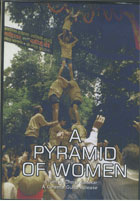
A Pyramid of Women 2004
Distributed by Cinema Guild, 115 West 30th Street, Suite 800, New York, NY 10001; 212-685-6242
Produced by Comet Media Foundation
Directed by Cheryl Kanekar
DVD-R, color, 20 min.
Jr. High - Adult
Women's Studies, Economics, Gender Studies, Multicultural Studies, Postcolonialism
Date Entered: 06/02/2006
Reviewed by Ciara Healy, Wake Technical Community College, Raleigh, NCCheryl Kanekar’s film A Pyramid of Women documents a group of women who participate in the Gokulashtami Festival, which celebrates the birth of the Hindu god Krishna. Traditionally, neighborhood men work together to construct human pyramids in an effort to reach and break clay pots strung up several stories high. Kanekar’s film is about the Gorakhnath Association, which is India’s first team of women attempting to form pyramids to break the pots.
Kanekar emphasizes the festival’s often aggressive sexual undertones by quoting a line from one of the traditional songs sung during Gokulashtami: “watch out for your pots, the men are out to get them.” The woman’s role, in part, in the god Krishna’s story, is one of adoring infant Krishna’s impishness and later admiring his sexual indulgences. In fact, the pot that teams compete to break represents Krishna’s love of butter and his constant attempts to steal butter from dairy maids and female family and friends.
Gorakhnath Association’s team members are women and girls (and some years, young boys) from a region in India known for women participating in sports. With the help of coaches, Gorakhnath neighborhood women practice their pyramids in preparation for Gokulashtami. The culmination of the film shows the team during its first Gokulashtami Festival in Mumbai in 2001 and their attempt to break 15 pots in one day. While they may not break each pot they attempt, they are ultimately triumphant and each year since have been flooded with applications from girls to join the Association’s pyramid team. They remain the only women’s team in India.
The origins of the women’s pyramid team, Kanekar’s posits, can be found in the postcolonial economic shifts that led traditional Indian women to work for wages outside of the home or take in piecework to earn money to help support their families. Kanekar also interviews a team member’s uncle, an Indian textile worker, telling how the collapse of that industry has displaced more and more men from their jobs as mill workers. The women’s pyramid team is seen to be an illustration of how working for wages (as opposed to unpaid labor performed at home such as child rearing) has given Indian women the confidence to challenge cultural traditions. The weakening of the male role of provider, especially since the close of Gorakhnath’s Svadeshi Mill, creates space for this.
Yet the Gorakhnath Association’s president Shalaka Korgonkar is proud to point out that the team can only practice at night after all of the household chores are done. This also illustrates a national and cultural pride among Indian women who are willing to fulfill both traditional home duties and work for wages to keep their families going. The image of women supporting their families through their labor and supporting each other literally, while forming human pyramids, is clear and distinct throughout the film.
A Pyramid of Women shows conflicting aspects of Indian women’s traditional roles as they have become more complex because of shifting economic and cultural practices. I recommend this film because its focus is local, showing how those shifts have affected the men and women of the Gorakhnath neighborhood in their work and in their leisure. But Kanekar’s point is a broader one about shifting gender roles in postcolonial Indian culture and it is aptly illustrated in her film. A Pyramid of Women would be a good addition to a college media collection that supports a women’s studies program/ department or has classes that look at “globalization” broadly construed, especially sociology and economics.
Awards
- Winner, Outstanding Documentary Award, School of Television and Film, San Diego State University